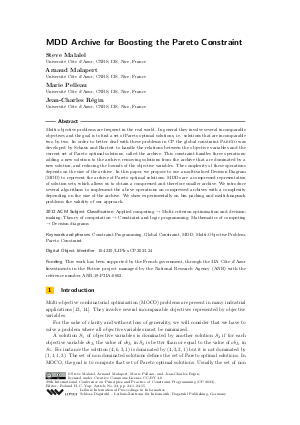MDD Archive for Boosting the Pareto Constraint
Authors Steve Malalel, Arnaud Malapert, Marie Pelleau, Jean-Charles Régin
-
Part of:
Volume:
29th International Conference on Principles and Practice of Constraint Programming (CP 2023)
Part of: Series: Leibniz International Proceedings in Informatics (LIPIcs)
Part of: Conference: International Conference on Principles and Practice of Constraint Programming (CP) - License:
 Creative Commons Attribution 4.0 International license
Creative Commons Attribution 4.0 International license
- Publication Date: 2023-09-22
File

PDF
LIPIcs.CP.2023.24.pdf
- Filesize: 0.75 MB
- 15 pages
Document Identifiers
Subject Classification
ACM Subject Classification
- Applied computing → Multi-criterion optimization and decision-making
- Theory of computation → Constraint and logic programming
- Mathematics of computing → Decision diagrams
Keywords
- Constraint Programming
- Global Constraint
- MDD
- Multi-Objective Problem
- Pareto Constraint
Metrics
- Access Statistics
-
Total Accesses (updated on a weekly basis)
0Document
0Metadata
Abstract
Multi-objective problems are frequent in the real world. In general they involve several incomparable objectives and the goal is to find a set of Pareto optimal solutions, i.e. solutions that are incomparable two by two. In order to better deal with these problems in CP the global constraint Pareto was developed by Schaus and Hartert to handle the relations between the objective variables and the current set of Pareto optimal solutions, called the archive. This constraint handles three operations: adding a new solution to the archive, removing solutions from the archive that are dominated by a new solution, and reducing the bounds of the objective variables. The complexity of these operations depends on the size of the archive. In this paper, we propose to use a multi-valued Decision Diagram (MDD) to represent the archive of Pareto optimal solutions. MDDs are a compressed representation of solution sets, which allows us to obtain a compressed and therefore smaller archive. We introduce several algorithms to implement the above operations on compressed archives with a complexity depending on the size of the archive. We show experimentally on bin packing and multi-knapsack problems the validity of our approach.
Cite As Get BibTex
Steve Malalel, Arnaud Malapert, Marie Pelleau, and Jean-Charles Régin. MDD Archive for Boosting the Pareto Constraint. In 29th International Conference on Principles and Practice of Constraint Programming (CP 2023). Leibniz International Proceedings in Informatics (LIPIcs), Volume 280, pp. 24:1-24:15, Schloss Dagstuhl – Leibniz-Zentrum für Informatik (2023)
https://doi.org/10.4230/LIPIcs.CP.2023.24
BibTex
@InProceedings{malalel_et_al:LIPIcs.CP.2023.24,
author = {Malalel, Steve and Malapert, Arnaud and Pelleau, Marie and R\'{e}gin, Jean-Charles},
title = {{MDD Archive for Boosting the Pareto Constraint}},
booktitle = {29th International Conference on Principles and Practice of Constraint Programming (CP 2023)},
pages = {24:1--24:15},
series = {Leibniz International Proceedings in Informatics (LIPIcs)},
ISBN = {978-3-95977-300-3},
ISSN = {1868-8969},
year = {2023},
volume = {280},
editor = {Yap, Roland H. C.},
publisher = {Schloss Dagstuhl -- Leibniz-Zentrum f{\"u}r Informatik},
address = {Dagstuhl, Germany},
URL = {https://drops.dagstuhl.de/entities/document/10.4230/LIPIcs.CP.2023.24},
URN = {urn:nbn:de:0030-drops-190610},
doi = {10.4230/LIPIcs.CP.2023.24},
annote = {Keywords: Constraint Programming, Global Constraint, MDD, Multi-Objective Problem, Pareto Constraint}
}
Author Details
Funding
This work has been supported by the French government, through the 3IA Côte d'Azur Investments in the Future project managed by the National Research Agency (ANR) with the reference number ANR-19-P3IA-0002.
References
- David Bergman, André A. Ciré, Willem-Jan van Hoeve, and John N. Hooker. Decision Diagrams for Optimization. Artificial Intelligence: Foundations, Theory, and Algorithms. Springer, 2016. URL: https://doi.org/10.1007/978-3-319-42849-9.
- Randal E. Bryant. Graph-based algorithms for boolean function manipulation. IEEE Trans. Computers, 35(8):677-691, 1986. URL: https://doi.org/10.1109/TC.1986.1676819.
-
Marco Gavanelli. An algorithm for multi-criteria optimization in csps. In ECAI'02: Proceedings of the 15th European Conference on Artificial Intelligence, pages 136-140, January 2002.

- Renaud Hartert and Pierre Schaus. A support-based algorithm for the bi-objective pareto constraint. Proceedings of the National Conference on Artificial Intelligence, 4:2674-2679, June 2014. URL: https://doi.org/10.1609/aaai.v28i1.9119.
- T.Y.K. Kam and Robert K. Brayton. Multi-valued decision diagrams. Technical Report UCB/ERL M90/125, EECS Department, University of California, Berkeley, 1990. URL: http://www2.eecs.berkeley.edu/Pubs/TechRpts/1990/1671.html.
- Sanaz Mostaghim and Jürgen Teich. Quad-trees: A Data Structure for Storing Pareto Sets in Multiobjective Evolutionary Algorithms with Elitism, pages 81-104. Springer London, London, 2005. URL: https://doi.org/10.1007/1-84628-137-7_5.
-
Guillaume Perez. Decision diagrams: constraints and algorithms. PhD thesis, Université Côte d'Azur, 2017.

-
Guillaume Perez and Jean-Charles Régin. Constructions and in-place operations for mdds based constraints. In Claude-Guy Quimper, editor, Integration of AI and OR Techniques in Constraint Programming, pages 279-293, Cham, 2016. Springer International Publishing.

- Charles Prud'homme and Jean-Guillaume Fages. Choco-solver: A java library for constraint programming. Journal of Open Source Software, 7(78):4708, 2022. URL: https://doi.org/10.21105/joss.04708.
- Khadija Salem and Yann Kieffer. An experimental study on symmetry breaking constraints impact for the one dimensional bin-packing problem. In Conference: 2020 Federated Conference on Computer Science and Information Systems, pages 317-326, September 2020. URL: https://doi.org/10.15439/2020F19.
-
Pierre Schaus and Renaud Hartert. Multi-objective large neighborhood search. In Christian Schulte, editor, Principles and Practice of Constraint Programming, pages 611-627, Berlin, Heidelberg, 2013. Springer Berlin Heidelberg.

- A. Srinivasan, T. Ham, S. Malik, and R. K. Brayton. Algorithms for discrete function manipulation. In 1990 IEEE International Conference on Computer-Aided Design. Digest of Technical Papers, pages 92-95, 1990. URL: https://doi.org/10.1109/ICCAD.1990.129849.
- Taha Vafaeenezhad, Reza Tavakkoli-Moghaddam, and Naoufel Cheikhrouhou. Multi-objective mathematical modeling for sustainable supply chain management in the paper industry. Computers & Industrial Engineering, 135:1092-1102, 2019. URL: https://doi.org/10.1016/j.cie.2019.05.027.
- Yihan Wang, Zongguo Wen, Jianguo Yao, and Christian Doh Dinga. Multi-objective optimization of synergic energy conservation and co2 emission reduction in china’s iron and steel industry under uncertainty. Renewable and Sustainable Energy Reviews, 134:110128, 2020. URL: https://doi.org/10.1016/j.rser.2020.110128.
